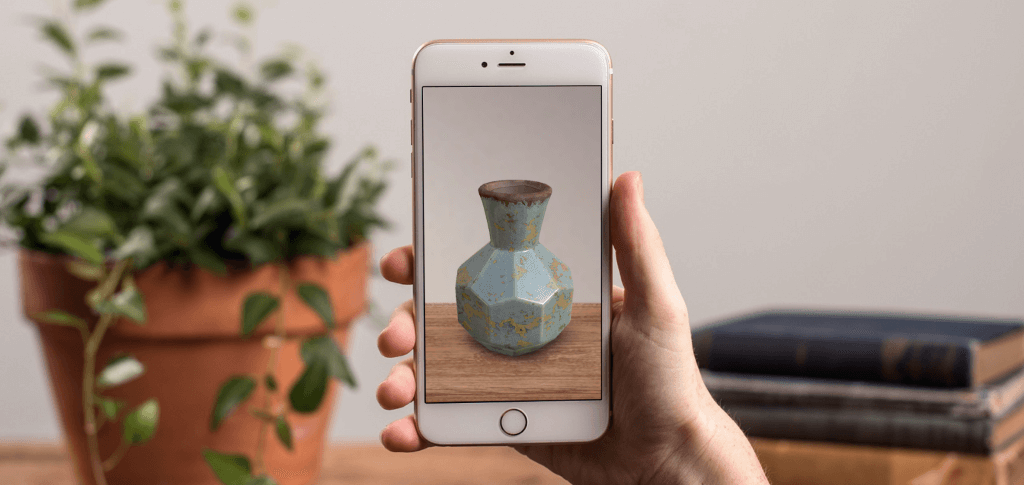Augmented Reality in Ecommerce - buzz or business?
Comic Snapchat filters, virtual clothes fit in front of a magic mirror. Or project a new corner sofa in 3D in your living room to see if it comes into its own. Or fill a catwalk in corona time with a new, holographic reality. It's all possible, it all happens. And the prediction is that Augmented Reality – also called Virtual Reality, although there are substantial differences – will play an important role in the online Customer Experience. For many lifestyle brands, Augmented Reality is in Ecommerce everyday reality.
Augmented Reality (AR) falls under the immersive technologies. You use it to create experiences in which customers can fully 'immerse' themselves (immersion). The user is sucked into an artificial environment or virtual reality in real time and in his or her everyday reality. The phenomenon has been around for some time. Think of the image of a packed cinema hall, in which the audience is decked out with 3D glasses to undergo a visual spectacle. Augmented Reality has also been hot on social media and in iPhone use for some time. But augmented reality in Ecommerce now seems to be on the verge of a breakthrough.
No buzz but big business
Coromandel, it's been a long time no buzz more, Augmented Reality in Ecommerce. On the contrary, it is big business. According to research by Statistica, which is headquartered in New York, the global AR technology market will be worth more than US $ 18 billion by 2023. The same market research shows that by 2022, consumers worldwide plan to spend US $ 15 million on mobile devices that facilitate AR.
With the rapid rise of Augmented Reality, it is logical that the manufacturing industry is looking for applications that can make the 'virtual, immersive experience'. The fashion industry and the design world are leading the way in this respect. The application of Augmented Reality in Ecommerce is increasing, although it is still a pioneering process. But the conviction is that AR will lift the Customer Experience to a new dimension.
Experiments with Augmented Reality in Ecommerce
For example, AR technology seems ideally suited to compensate for the lack of personal contact between the customer and the sales adviser in online shopping. The COVID epidemic is currently making this loss even more keenly felt. Under 'normal' circumstances the Customer Journey has several stages. touchpointsincluding contact in the physical store. In many countries, store closures are part of the lockdown, eliminating real contact with the customer. This is particularly noticeable in the fashion world.
It is therefore understandable that experiments with Augmented Reality in Ecommerce are mainly in the world of the more expensive luxury goods. Think of fashion, cosmetics and home furnishings. There are plenty of examples. In London in February of this year, for example, the London Fashion Week place. The catwalk remained empty. However, with a special app, lovers of haute couture could follow the latest trends thanks to 5G on their smartphones in the form of a holographic fashion show.
Magic mirror and Swedish app
Fashion and cosmetics brand Chanel is experimenting with a 'magic mirror' that allows customers to try on virtual fashion items at home. Sweden's well-known home furnishing store is among the pioneers. The IKEA Pace app allows you to "place" home furnishings in your home in 3D and on a true-to-life scale. It lets you see if the products fit in your home.
To sum up, there are plenty of examples of what AR technologies can add to customer loyalty and conversion. Also in reducing returns, by the way. After all, when customers 'place' virtual products and try them out in their everyday reality, the chance of disappointing orders decreases. But it is not that far yet. Despite the fact that Augmented Reality in Ecommerce already offers new opportunities, its application seems to be reserved for the big brands and for fun purposes. But that is about to change.
AR adds valuable dimension to Customer Journey
AR is the technology par excellence to add special dimensions to daily reality by means of digital information. This is already happening on a large scale in entertainment, commerce will follow. Both on the shop floor and online, to strengthen other forms of presentation and contact. Augmented Reality in Ecommerce serves one ultimate purpose: adding maximum value to the personalized Customer Journey.
Do you want to be ready in time for the 'new reality'? You can always get a meet with us.


